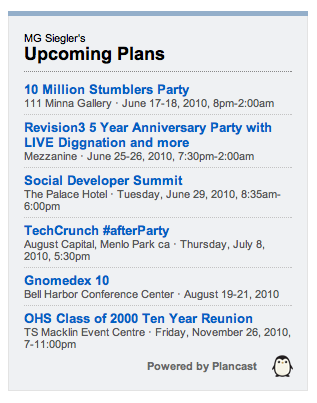 Plancast, the social planning service created by TechCrunch alum Mark Hendrickson, is rich with data. It knows not only what you’re planning to do in the foreseeable future, but what your friends are planning, and what their friends are planning. But all of this data has been trapped inside of Plancast. Not anymore.
Plancast, the social planning service created by TechCrunch alum Mark Hendrickson, is rich with data. It knows not only what you’re planning to do in the foreseeable future, but what your friends are planning, and what their friends are planning. But all of this data has been trapped inside of Plancast. Not anymore.
Today, the service is announcing its API. This gives developers the ability to build new apps using Plancast’s data — or to add that data to their existing apps. And the API is both read and write-enabled, so other services will be able to feed their data back into Plancast as well. The importing of event data from Facebook (through Connect) has helped Plancast grow, so this full read/write API should be a continuation of that.
Actually, the API work started out of necessity for Plancast. They needed it in order to build their iPhone app in time for the SXSW conference back in March. Since then, the API has been rebuilt, Hendrickson tells us. And it’s already been tested with some third-party developers such as Exygy, which built a Plancast Andorid app (aptly named Plandroid).
Currently the API only support basic authentication (username/password), but that’s because Hendrickson wants to enable OAuth 2.0 as soon as it’s ready.
 Alongside the API, Pancast is also launching its first widgets and buttons as yet another way to help seed its data around the web. The widgets look great — they use a simple JavaScript embed that allows you to display all of the upcoming plans you have on a website you control (such as a blog’s sidebar). There is also a full page profile widget which was created because people were porting their data to things like Google Calendar and then embedding those to show their Plancast events. This solution is much more seamless.
Alongside the API, Pancast is also launching its first widgets and buttons as yet another way to help seed its data around the web. The widgets look great — they use a simple JavaScript embed that allows you to display all of the upcoming plans you have on a website you control (such as a blog’s sidebar). There is also a full page profile widget which was created because people were porting their data to things like Google Calendar and then embedding those to show their Plancast events. This solution is much more seamless.
Then, of course, there are buttons for those who don’t want to embed their data but want a cutesy way to link to their Plancast profile. And yes, one of them has the cute penguin logo on it.
“These are the first pieces of our general platform strategy in which we want to power any and all plan-related listings on the web and do so with a thoroughly social context,” Hendrickson says about the new elements of Plancast. He notes that they have some other cool ideas in the works — particularly surrounding places, something which Twitter and Google are now targeting (not to mention Foursquare, Gowalla, Loopt, etc).
Again, you can read all about Plancast’s API here.
